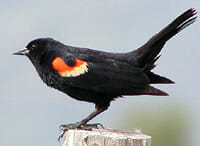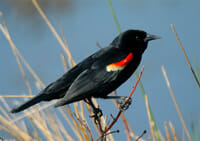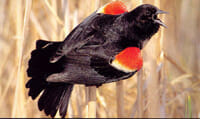Red-winged Blackbird – Passeriformes Ictidae Agelaius phoeniceus
 |
 |
 |
Identification & Description:
• Large hawk.
• Medium-sized songbird.
• Moderately long and slender bill.
• Tail of medium length.
• Male plumage is well described by the name.
• Size: 17-23 cm (7-9 in)
• Wingspan: 31-40 cm (12-16 in)
• Weight: 32-77 g (1.13-2.72 ounces)
Sex Differences
Male black with red shoulders, female brown and striped all over.
Facts
• Different populations and subspecies of Red-winged Blackbirds vary markedly in size and proportions. An experiment was conducted that moved nestlings between populations and found that the chicks grew up to resemble their foster parents. This study indicated that much of the difference seen between populations is the result of the different environments.
• The Red-winged Blackbird is a highly polygynous species, with one male having up to 15 different females making nests in his territory. In some populations 90% of territorial males have more than one female. But, from one quarter to up to half of the young in “his” nests do not belong to the territorial male. Instead they have been sired by neighboring males.
• The male Red-winged Blackbird fiercely defends his territory during the breeding season. He may spend more than a quarter of all the daylight hours in territory defense. He vigorously keeps all other males out of the territory and defends the nests from predators. He will attack much larger animals, including horses and people.
• The Red-winged Blackbird forms roosting congregations in all months of the year. In the summer it will roost in small numbers at night in the wetlands where it forages and breeds. In winter, it can form huge congregations of several million birds, which congregate in the evening and spread out each morning. Some may travel as far as 80 km (50 mi) between the roosting and feeding sites. It commonly shares its winter roost with other blackbird species and European Starlings.
Other Names
Carouge à épaulettes (French)
Tordo alirrojo, Tordo capitán, Mayito de la ciénaga, Sargento (Spanish)
The red-winged blackbird is a member of the family Emberizidae, in the order Passeriformes, and is classified as Agelaius phoeniceus.
Red-Winged Blackbird, common name for a colorful songbird found throughout the United States, Canada, Mexico, and south to Costa Rica. It is one of the few birds found in every U.S. state except Hawaii. It lives in many habitats including marshes, brushy swamps, and fields.
The red-winged blackbird measures 18 to 24 cm (7.0 to 9.5 in) in length. The male is jet black and develops bright red shoulder patches, sometimes with a lower yellow border, during the spring. The red patches are concealed most of the time. The female plumage varies by region but is usually brownish with well-defined dark striping on the underparts. The immature plumage is similar to that of the female but with red shoulder patches.
The red-winged blackbird eats seeds from grasses, weeds, and grain, and insects including beetles, grasshoppers, and caterpillars. It may also eat snails and spiders. The red-winged blackbird uses its sharp beak to catch insects and other food. During the non-breeding season, it forages in shrubs and trees and on the ground.
The red-winged blackbird is a flocking bird. It migrates, feeds, and defends itself within a group of other birds. If a hawk or a heron approaches, many blackbirds will gang up, harass the bird, and drive it away from their nests and young.
Red-winged blackbirds often nest in marshes near cattails or bulrushes, usually close to water. Males aggressively defend their nesting areas throughout the nesting season. The male declares his area by standing on a reed, flashing his red shoulders, and singing. He will often have more than one mate. The female builds a bulky cuplike nest made of grass, reeds, and leaves, lined with finer materials, and lays three to four pale bluish-green eggs. She incubates, or warms, the eggs for 10 to 12 days until they hatch. Both the male and female help feed the young who first fly 11 to 14 days after hatching.